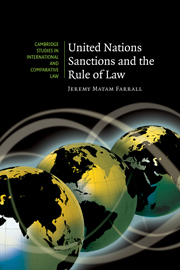Book contents
- Frontmatter
- Contents
- Extended Table of Contents
- Preface
- Abbreviations
- Part I Setting the scene
- Part II The evolution of the UN sanctions framework
- Part III UN sanctions in practice
- 5 Establishing the legal basis for sanctions: identifying threats and invoking Chapter VII
- 6 Delineating the scope of sanctions and identifying targets
- 7 Fine-tuning sanctions: setting objectives, applying time-limits and minimising negative consequences
- 8 Delegating responsibility for sanctions administration and monitoring
- Part IV Strengthening the rule of law
- Appendix 1 Summary of policy recommendations
- Appendix 2 Summaries of UN sanctions regimes
- Appendix 3 Tables
- Bibliography
- Index
- Cambridge Studies in International and Comparative Law
7 - Fine-tuning sanctions: setting objectives, applying time-limits and minimising negative consequences
Published online by Cambridge University Press: 26 June 2009
- Frontmatter
- Contents
- Extended Table of Contents
- Preface
- Abbreviations
- Part I Setting the scene
- Part II The evolution of the UN sanctions framework
- Part III UN sanctions in practice
- 5 Establishing the legal basis for sanctions: identifying threats and invoking Chapter VII
- 6 Delineating the scope of sanctions and identifying targets
- 7 Fine-tuning sanctions: setting objectives, applying time-limits and minimising negative consequences
- 8 Delegating responsibility for sanctions administration and monitoring
- Part IV Strengthening the rule of law
- Appendix 1 Summary of policy recommendations
- Appendix 2 Summaries of UN sanctions regimes
- Appendix 3 Tables
- Bibliography
- Index
- Cambridge Studies in International and Comparative Law
Summary
In addition to identifying the legal basis and delineating the scope of sanctions, the Council can also take a number of steps to fine-tune the manner in which sanctions will be applied. As part of its sanctions practice, the Council has fine-tuned its Article 41 measures by clarifying particular objectives whose fulfilment would lead to the suspension or termination of sanctions. It has applied sanctions against a range of targets. It has experimented with the use of time-delays and time-limits, and it has also attempted to respond to criticism of the negative consequences of sanctions upon civilian populations and third-states.
Setting sanctions objectives
As UN sanctions are imposed under Chapter VII of the UN Charter, the implicit general objective of any sanctions regime is to address the threat to the peace, breach of the peace or act of aggression that led to the imposition of sanctions, and thus to maintain or restore international peace and security. In addition to that general objective, however, sanctions regimes generally possess a more specific objective, or set of objectives, the achievement of which should ensure the maintenance or restoration of peace and thus lead to the termination of sanctions.
- Type
- Chapter
- Information
- United Nations Sanctions and the Rule of Law , pp. 133 - 145Publisher: Cambridge University PressPrint publication year: 2007



